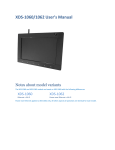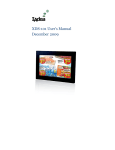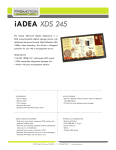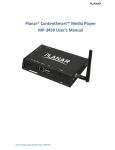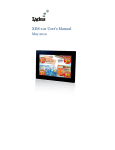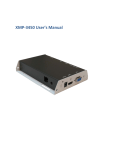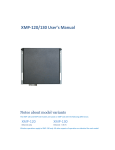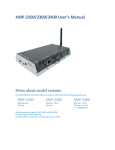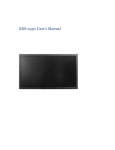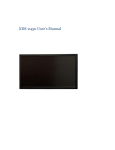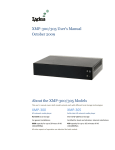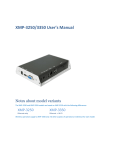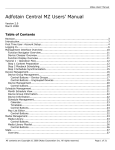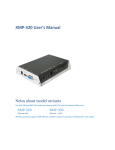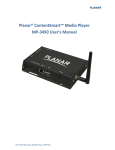Download NMP-200U User`s Manual
Transcript
XDS-104 User’s Manual Contents 1. Introduction 1 Features 1 Package contents 1 Physical ports and features 1 2. Configuring the XDS-104 2 System connections 2 USB keyboard configuration menus 2 Navigating the menus 2 Connect the XDS-104 to your network 2 Clock and calendar settings 3 Brightness and Volume settings 4 Setting a password 4 Factory reset 5 Applying firmware upgrades 5 3. Content Management 6 4. Working with SMIL 7 Introduction 7 www.a-smil.org for developers 7 5. Technical Data Specifications 6. Appendix: FAQ 8 8 9 i 1. Introduction This document describes the hardware and software operations of the XDS-104, system set up, and frequently asked questions. Features 10-inch widescreen LCD display and stereo speakers Built-in wireless b/g network and optional USB Ethernet adapter Supports advanced device programming via the W3C SMIL open API Package contents Main Unit AC Adapter Quick Start Guide Software CD NOT INCLUDED: A USB keyboard is required for system setup Physical ports and features 1 2. Configuring the XDS-104 System connections 1 Attach the AC power adapter to power on the unit. The following progress bar will be displayed on your monitor: ~ 90 seconds 2 Player boot process takes approximately 90 seconds to complete. After boot up, the player will indicate that it is ready for content sync via the USB port. The player will boot into the “Open Standard Media Player” screen. Plug in a USB keyboard to enter configuration menus. The menu and blue background will appear in about 30 seconds. If you have already loaded media contents into the player, contents will play back immediately after boot up, and the “Open Standard Media Player” screen will not be shown. You can still plug in a USB keyboard at any time during playback to enter the menu system. USB keyboard configuration menus You must attach a USB keyboard to the XDS-104 to configure settings. With the player booted up and ready, it takes approximately 30 seconds after you plug in the keyboard for the following menu to be displayed: Navigating the menus Navigate the menus using arrow keys, space bar, enter key, ESC, and numeral keys on your USB keyboard. Use the keyboard arrow keys to highlight menu items, press the space bar to move the star (cursor), and then press enter to confirm (<OK>) or reject (<Cancel>) any changes. Connect the XDS-104 to your network Determine a connection type Wireless connection (built-in): The player will scan for wireless signals nearby during boot up. If the network requires authentication, you will be asked to provide the password for access. 2 Wired connection (OPTIONAL): Attach the USB Ethernet Adapter accessory (sold separately; part no. IAD-ACC-ITM-0019) to media player’s USB port and connect a LAN cable to the adapter’s other end (RJ45 port). REBOOT player to initialize the adapter. Player IP address You will also need an IP address for the player on your network. This could be set automatically (DHCP) or manually (static IP): 1) DHCP – automatically assign network IP address DHCP is enabled by default. You do not need to change the settings unless setting a static IP. 2) Static – manually assign network IP address Move the highlight to “Static IP” below, press “Space bar” on the keyboard to fill in the star (*) at the Static IP brackets, and press “Enter” on the keyboard to select <OK>. Highlight “IP configuration” and press “Enter” on keyboard to <Select> Proceed to configure an available static IP address. Please ask your network administrator for assistance if necessary Clock and calendar settings Time and Time Zone must be set correctly for scheduled playback. 3 Highlight “Time setting” and press “Enter” on keyboard to <Select> SET local time, then SET time zone. Daylight Saving (DST) rules can be configured when you enter the Set time zone submenu. Brightness and Volume settings From the Main Menu, select Output setting to enter the submenu. You can enter the display brightness of the backlight in percentage (%) from 0 (dimmest) to 100 (brightest) You can enter the sound level in percentage (%) from 0(quietest) to 100 (loudest) or in decibels (db) from -22 (quietest) to 0 (loudest) Setting a password To prevent your player settings from being modified, set a player password to hide the menus. From the top level menu, select “Change password” to set a password. Once a password is set, you can only access the menus by connecting a USB keyboard and pressing CONTROL + ALT + DELETE (3-key combination) simultaneously. You may connect the keyboard at any stage of player operation or before/ during bootup. If you forget the password, you will need to reset the device. See Factory reset. 4 Factory reset If you forget a system password you have set, you must reset the system to regain access to the player. System reset will re-initialize the system, clear passwords, and return settings to their default values. Perform the following: 1. Connect USB keyboard 2. Reboot the player and look for the reset instructions on the top left (circled area in red). When it appears, press the Delete key on your keyboard If you missed the reset window, unplug power and try again 3. 4. You should see a menu with a reset confirmation dialogue box. SELECT Yes to confirm WAIT while system reboots to complete reset Applying firmware upgrades Firmware updates can be performed using a USB flash drive or via network using Manager Express. Please read the release notes carefully regarding the changes that will be made to your player before applying the upgrade 1. 2. 3. 4. Obtain the latest firmware and copy it to the root directory of a USB drive Power on device and plug USB keyboard to the device to enter menu system Follow on screen instructions and select firmware upgrade option in the menu When instructed, plug in the USB drive to begin firmware upgrade 5 3. Content Management Please see the software set up instructions for your management system 6 4. Working with SMIL The XDS-104 uses open communications protocols for highly flexible content presentation and playback control. SMILcompliance means predictable results across multiple devices, and SMIL’s non-proprietary nature means that your investments are never obsolete. Introduction Using SMIL (pronounced “smile”), the language created by W3C for multimedia communications, the media player understands the language “spoken” by professional tools from companies such as Adobe, Apple, Microsoft, and Real Networks. What this means is quicker, easier, and better integration of your players into your digital signage networks, opening up avenues of software controls and realizing the full potential of your player hardware down the road. www.a-smil.org for developers The media player utilizes W3C SMIL open standard, making it easier to customize to your project management needs. For resources, downloads, and community support, please visit www.a-smil.org. 7 5. Technical Data Specifications XDS-104 Display and Sound 10.1” TFT LCD wide aspect ratio 300 nits maximum brightness 800x480 native resolution Built-in stereo speakers 2 Wx2 Video format support MPEG-1 or MPEG-4 ASP (up to 2 Mbps bitrate) Recommended 16:9 video resolution: 640x360 or 720x400 Image format support JPEG baseline (800x480 recommended resolution) Audio codec support MP3 or MPEG L2 audio (up to 384Kbps) Playback control W3C SMIL 3.0 instructions (sub-set) Real-time clock playlist events Network playlist sync USB direct sync Content management WAN – 3rd party solution LAN – Manager Express software USB direct update Network Connectivity and I/O Ports Wi-Fi: IEEE 802.11 b/g/n Wi-Fi Security: WPA/WPA2, TKIP/AES Ethernet: RJ45 Port via USB dongle (option) USB storage host (Type A) 3.5mm stereo audio out jack Digital Signage Features “Power auto on” upon power cord attach Automatic error recovery (built-in WDT) Real-time clock with 12-hour backup battery Automatic NTP clock adjustment Local storage Internal 2GB NAND flash Memory card slot: Secure Digital Card (SD/SDHC) Accessories Printed Hardware quick start guide AC power adapter Landscape type stand SOftware CD (Optional) Printed Software quick start guide(Optional) VESA mounting kit (Optional) Power supply 12V, 1.5A DC Power consumption 12W typical Environmental Operating temperature: 0 – 40° C / 32 – 104° F Humidity: 5 – 85% @ 40° C / 32 – 104° F non-condensing Dimensions (WxHxD) 272 x 185.8 x 34.5 mm (10.6” x 7.28” x 1.14”) Weight 663 grams (1.46 lbs.) Safety UL-approved AC adapter Certifications CE/FCC RoHS Warranty One-year limited parts & labor 8 6. Appendix: FAQ What is the maximum file size for a single video file? The maximum video file size for the XDS-104 is 2GB. We recommend reserving a safety margin to avoid exceeding the limit (i.e. limiting files to 1850MB). How do I manage the playback of contents? Playback on a schedule is one of the main functions of the XDS-104. For most users, it can be managed via the easy to use Adfotain Manager Express software. Scala users may obtain a player license from Scala to manage the media player directly from Scala Content Manager. For advanced customization, there is SMIL compatibility. See the developer’s manual for customizing the player with open-standard W3C SMIL commands. About Adfotain Manager Express: Unlike the difficulty of programming VCRs from a remote control, the Adfotain Manager Express software is designed to be simple by using a graphical personal computer interface. Playback contents are laid out visually in a calendar view. Anyone with basic computer skills can quickly create or modify schedules, delivering the right message to the right audience at the right times. Please refer to the Adfotain Manager Express User’s Manual for detailed operations and techniques. Could the player display Flash or Microsoft PowerPoint presentations? The player features limited PowerPoint support, but not Flash support. While PCs can play many formats with varying degrees of success, RISC-based media players are designed to reliably play specific video formats (Please see spec for details). While Microsoft PowerPoint native files could not play directly on a RISC-based player, the file is converted through other software (i.e. Adfotain Manager Express) into an image format to be played as an image slideshow. Why won’t some media files play smoothly? The video data bit-rate may be higher than the recommended bit rate (2Mbps). MPEG-4 ASP is the required codec. Please search for the “transcode” tutorial at www.IAdea.com/support to transcode unplayable videos. The media playback looks different on a PC compared to the media player’s screen. (Wrong aspect ratio) The XDS-104 will always stretch contents to wide-screen aspect ratio (approx. 16:9), regardless of the native resolution of the video source. If you format your video for 16:9 (wide) in your editor, the output should be correct regardless of the encoding resolution. There are 2 major aspect ratios (width-to-height ratios) for video content, but many kinds of displays. If you play 4:3 video on a 16:9 display (or vice versa), a circle becomes oval, and the picture takes on a squeezed or stretched look. To avoid this distorted look, adding black bars are a common technique. Some JPEG images cannot be played in the media player. Progressive JPEG are not supported. Please convert to baseline JPEG for maximum compatibility. JPEG images can be either of 2 types: baseline or progressive compression. Baseline JPEG offers greatest compatibility, while progressive JPEGs are suitable for web site images. Progressive images are downloaded and displayed “progressively,” being rendered more clearly as more data is received over the internet. Devices with local storage such as the CF/Network Media Player are usually incompatible with the latter type. Make sure to save images as baseline JPEG in your photo editor, or resave them as baseline JPEGs using free tools such as Paint.net (http://www.paint.net/). Does the media player support video streaming? No, all media files are designed to play from local storage. During content and schedule sync, contents are transferred to player’s local storage before being presented on screen. This ensures the best possible presentation and fluid delivery of your video message. Video streaming raises many playback quality issues such as image freezing, blocking, or blue-screens, costing you valuable “air time” and losing your audience's attention. The media player is not playing. What should I do? Check the player’s messages on the display (OSD, or on screen display) for status information. Since RISC-based media player usually lack input devices such as keyboard or mouse like PCs, troubleshooting is 9 usually based on user’s knowledge and experience with the specific media player. First check the on screen message and stats reports. Bad play list and timing issues are two major causes of playback problems. To determine if the problem is caused by a bad play list, just delete the play list and restart player. The player should loop through all media files, indicating a fault with the play list. If the playback is scheduled to play at specific time, check to see if the device is set to the right time zone on the world clock. When nothing seems wrong, the time zone setting is often the reason the program is not played. 10 IAdea Limited Warranty For Integrated Display Devices Applicable to IAdea product models: XDS-104, XDS-104 1. IAdea provides, unless extended through optional service programs, one (1) year of limited warranty on its applicable product models listed above. The applicable product must be purchased through an authorized IAdea reseller. Subject to the conditions of this warranty, IAdea will perform necessary service on the product without charge for parts or labor if, in the opinion of IAdea, the product is found to be faulty within the warranty period. IAdea’s sole warranty and obligation will be to repair or replace (at it sole discretion) such products that require warranty during the applicable warranty period in accordance with these conditions. If the product is found to be in correct working order, then IAdea reserves the right to charge you for its time and materials costs. 2. Display products are allowed to have a maximum of three (3) bright pixels and a maximum of five (5) dark pixels. The product is found defective if the number of failed pixels is greater than the above listed. 3. This warranty only applies if the product has been under normal use and reasonable care (in the opinion of IAdea). The warranty covers normal usage for which the unit was originally supplied and does not cover damage, malfunction or failure resulting from use of incorrect voltages, unauthorized installation, accident, misuse, neglect, build-up of dirt or dust, abuse, power surge problems, thunderstorm activity, tampering or repair by unauthorized persons (including unauthorized alterations), unauthorized maintenance, exposure to abnormally corrosive conditions or any foreign object or matter having entered the product. 4. If warranty service is required you should contact IAdea at [email protected]. You will be required to fill out an RMA form and provide proof for your original date of purchase. 5. You will be responsible for shipping the product to designated IAdea service locations. You are required to pre-pay for the shipping and custom charges, if any, required for the shipment of the product to IAdea. The warranties hereby conferred do not extend to any costs associated with the delivery, handling, freighting or transportation of the product and do not extend to any damage or loss occurring during, or associated with, transit. IAdea currently provides warranty service locations in Taipei, Taiwan and Newark, California, USA. For questions or further information, please contact [email protected]. 11













